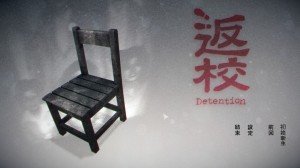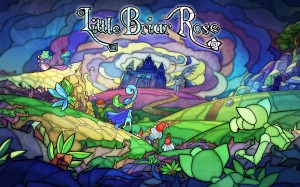Review for Blackwood Crossing

Blackwood Crossing commences on a train, as you glimpse the face of Scarlett, the teenage heroine, reflected in the window. Soon you hear Scarlett’s ten-year-old brother, Finn, calling for help. Finn is impulsive and rowdy and wears a makeshift superhero costume with a large “F.” At first, Scarlett and Finn are alone on the train, but soon they encounter a child in a sailor suit and rabbit mask. This vision dissolves into confetti when approached, and the story soon dips even further into the fantastical. Scarlett notes that they’ve gone through the looking glass, but this is an entirely different world than Alice’s. And it’s just the beginning of four hours of plot surprises, intuitive puzzles, and chills up your spine.
Though Scarlett is the playable protagonist, Finn really runs the show. At the start, he issues orders in a well-integrated “Simon Says” tutorial, revealing the simple interface. You spend significant time following Finn, looking for Finn, and reasoning with Finn. He purposely confronts Scarlett, playing off her frustration with his demands, her desire to fix things, and her memories of the past. Detailed animation brings this boy endearingly to life as he romps, shrugs, and sneaks, including close-ups where he gestures as he talks – eyes widening or drooping in his expressive face. You begin to get a sense of Finn’s spontaneity and creativity mixed up with bursts of anger, along with Scarlett’s desperation to resolve a tragedy that shadows them both.
The sumptuous, colorful 3D environments encompass the train, a treehouse, and a lush island. Each contains details designed to add emphasis to the plot: offbeat posters on the train, a stone folly, swirling lights in the treehouse planetarium, a toy rocket and hot air balloon. Ambient sounds and movement add vitality, whether the clack of train wheels and landscapes zooming by, gentle waves with water lapping near the island shore, the sizzle and flicker of fire, or the whoosh and gleaming coils when inert objects spring to life. Background music is subtle and effective, including reflective guitar and piano passages and spooky, sustained orchestral tones.
The settings mutate during the course of the story, from day to night and from realistic to brilliantly surreal. You are never comfortable in Blackwood Crossing. Just when you think you understand what’s happening, the environments morph or the characters disappear and reappear. This is clearly not a game I would play in the company of a young child, as it boomerangs between trepidation and painful truths as to the outcome of Finn’s temper and Scarlett’s neglect. Figuring out the symbolisms, character relationships, and past events are some of the most significant challenges posed here.
Multiple non-player characters are presented in black-and-white except for the gaudy masks that cover their faces. British voice-overs perfectly suit the cast: the bully is aggravating, the schoolmistress persnickety, and Scarlett’s boyfriend charmingly flummoxed. Finn in particular is expertly performed (it’s tough to credibly portray a child’s voice). Brief but frequent dialogs sometimes contain attitude-laden choices. Though your selections affect what you learn about others, as far as I can tell they don’t change the plot. These enticing tidbits and fleeting cutscenes leave a web of clues showing how people are linked and whether past conflicts were resolved. They provide a snowballing mystery just waiting to be solved, and I was desperately curious as to how it all would end.
Looking back after the touching finale, I did find one aspect frustrating. There are only meager hints about one vital character – the boy in the rabbit mask. Unlike all the others, he seems a complete stranger to Scarlett and Finn. So how is he connected to them? Perhaps I missed something in the gameworld that would have provided the missing tie-up. Though I’m able to theorize about the rabbit boy’s purpose, it would have been extremely gratifying to understand it more fully.
Sometimes when a game has outlandish themes like those in Blackwood Crossing, the puzzles contain such weird solutions that they become nigh impossible. That is not at all the case here; the puzzles are on the easy side and don’t keep you struggling for long. This design decision keeps you feeling involved while granting full attention to the personalities and plot. You are solving the problems presented by Finn while also solving the mystery about him. Puzzles include a matching challenge, sequencing a visual pattern, breaking a lock, creating butterflies, searching for missing parts of ornaments, plus solving assorted inventory conundrums. You also gain powers that function in certain situations – the ability to give life and to control fire. One sequence can be completed (intriguingly) using opposite procedures that reveal different secrets.
I played the game on the PS4, but it works the same on a PC with a gamepad, though you can also use the traditional keyboard/mouse combo to maneuver and look around. It’s viewed from first-person perspective, using the left analog stick to walk about while scanning the locales for obvious hotspots, which highlight when you draw near and hover the cursor over them. The R1 and L1 buttons cycle through the inventory, which appears at the top of the screen. You can’t skip essential dialogs or cutscenes, but they are short enough (and interesting enough) that you probably won’t want to, unless you click on a character again and get the exact same response. The game autosaves at regular checkpoints, so I didn’t lose progress or have to repeat anything after quitting. But since I played the whole thing in two long sessions, my experience with stopping and resuming was admittedly limited.
Speaking of limitations, certain constraints have stuck with me after completing Blackwood Crossing. Nearly everything about the game is polished and beautifully focused, yet confined. Telling a story this well doesn’t require vast landscapes or protracted dialogs; for instance, think how much can be accomplished in a stage drama with minimal sets. Still, this game left me wanting more – not just larger environments to explore, but even more plot details and further nitty-gritty about the characters.
Blackwood Crossing demonstrates a trend that’s taking a subset of adventure games in a new direction: edgy, succinct writing, excellent production values, puzzles that further the story without slowing the pace, and tight, detailed locales. Adventure gamers who favor an emphasis on robust story and inventive character development will be delighted. Those who like to wander for hours through extensive terrain or unravel mind-boggling puzzles should stay away. This game wrapped me up in its piquant enigmas, made me care deeply about the characters, and kept me on the edge of my seat right up until the end. Crossing over from light to dark, from strife to acceptance seldom happens without a misstep, but this game handles it all with aplomb. Reaching the destination left me longing for more, yet the path is so creative and emotionally riveting that it’s well worth the journey.



_capsule_fog__medium.png)
























